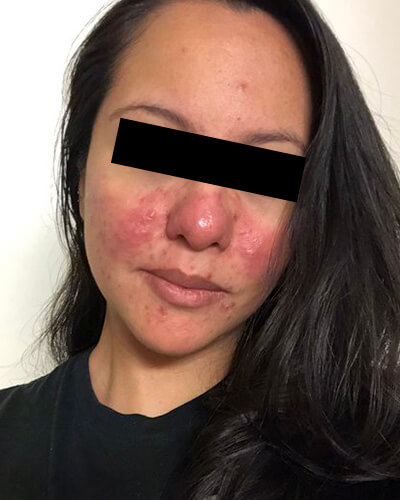
A 28-year-old female with a history of plaque psoriasis presents to the dermatology clinic for evaluation of facial oedema, erythema and enlargement of pores on the central face which have become more prominent over the last few months.
She has been applying topical pimecrolimus to the affected areas.
In addition, she has been on subcutaneous tildrakizumab, an interleukin-23 inhibitor, for the past year for plaque psoriasis.
She denies any recent changes in her diet or skincare routine.
On examination, there are a few erythematous papules on the nose, cheeks and chin.
The skin on the cheeks and nose is erythematous and thickened with enlarged pores and sebaceous glands. No comedones or pustules are present.
What is the diagnosis?
Correct!
Phymatous rosacea, derived from the Greek word “phyma” meaning growth, is a chronic inflammatory condition characterised by tissue hypertrophy, sebaceous gland hyperplasia and dilated hair follicles.
It most commonly affects the nose (rhinophyma), but can involve the ears (otophyma), chin (gnatophyma), eyelids (blepharophyma), and forehead (metophyma).
It is more common in men, contrasting with other subtypes of rosacea which mainly affect adult females aged 30-50, particularly those of Northern European heritage with fair skin.
Rosacea is a chronic inflammatory disease characterised by recurrent facial flushing, and typically presents with erythema, telangiectasias, papules, or pustules of the face.
Patients often report facial burning or stinging during flares. The diagnosis is clinical.
The papulopustular form of rosacea presents with facial papules and pustules which can appear similar to acne.
Rosacea lacks comedones, which can help differentiate the condition from acne vulgaris. A drug reaction would be more florid.
Sebaceous hyperplasia is caused by enlarged sebaceous glands. It presents as one or multiple skin-coloured or yellow papules with central umbilication, commonly located on the face but can appear on other regions.
Although sebaceous hyperplasia can co-occur with phymatous rosacea, in this case the features favour the latter.
Common rosacea triggers include extreme temperatures (hot, cold), UV exposure, spicy foods, alcohol, wind, exercise and stress.
The pathogenesis is not well characterised but a family history, environmental factors, micro-organisms (demodex mites, Helicobacter pylori), immune factors, and neurovascular dysregulation are thought to contribute.
There are several treatment options for phymatous rosacea. Topical treatment is not effective, but oral antibiotics (doxycycline 40mg once daily) or low-dose isotretinoin (0.3mg/kg daily) may slow the progression of the disease.
Severe cases can be treated with ablative lasers to debulk excess tissue, or less commonly, scalpel and loop electrosurgical excision.
Other options include cryosurgery, ionising radiation, and energy-based lasers (CO2 laser, pulsed dye laser, or YAG lasers).
Rosacea has also been reported to respond to secukinumab, a biologic that targets interleukin-17.
Patients should also be counselled on the importance of and trigger avoidance, photoprotection and use of gentle cleansers and moisturisers to maintain skin hydration and barrier function.
